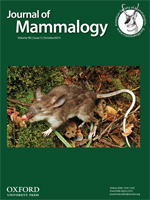We characterized population dynamics of nonmigratory cave bats, Myotis velifer, in Oklahoma by locating all 21 caves known to be occupied in an exhaustively searched, large study area, marking representative samples with numbered wing bands and conducting annual winter counts and recaptures over a decade. Bats moved readily among maternity caves during summer and among hibernating caves from winter to winter. The aggregate population of adults during lactation was about 13,600, including 10,500 females, of which 96% produced young. The aggregate population during winter was about 23,850 for the first 2 years of the study, declined to about 14,200 in the 3rd year, and recovered to > 20,000 for the last 4 years of the study. Mortality events and threats documented included flooding, subfreezing temperatures, and rock collapses in caves, as well as in-cave disturbance by humans, but the cause of the decline was not identified. We used capture—mark—recapture methods to estimate and model capture probability (P) and apparent survival (φ) from 1967–1968 to 1976–1977. Based on bats marked as weaned juveniles at maternity caves, survival was lowest in the first 6 months of age and increased steadily in later age classes. Females survived better than males. Based on subadult and adult bats marked in winter, survival increased over the 1st half of the bats' 10-year life span and then declined over the 2nd half. These results show that survival is strongly sex- and age-specific, with lower survival for juveniles than for older bats and lower survival for males than for females. Site fidelity was relatively weak, apparently enabled by the local abundance and proximity of caves. Rapid recovery from a large population decline indicates substantial resilience in this metapopulation. In contrast, relatively stable numbers in the years before and after the decline suggest that some factor may limit population size under normal conditions.
How to translate text using browser tools
29 September 2015
Population Dynamics and Site Fidelity of the Cave Bat, Myotis velifer, in Oklahoma
Stephen R. Humphrey,
Madan K. Oli
ACCESS THE FULL ARTICLE

Journal of Mammalogy
Vol. 96 • No. 5
October 2015
Vol. 96 • No. 5
October 2015
capture probability
cave bat
demography
metapopulation
site fidelity
survival rate




